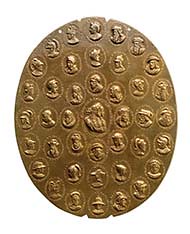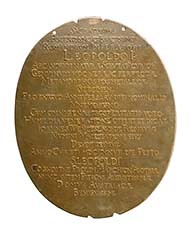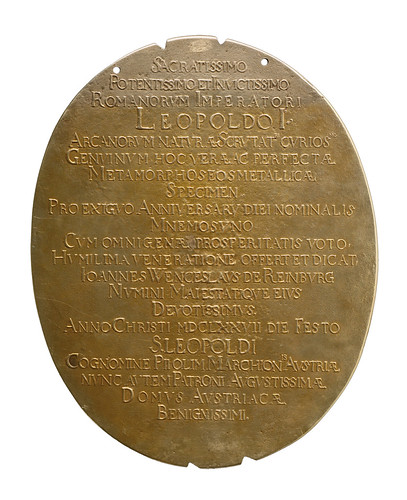
PREV ARTICLE
NEXT ARTICLE
FULL ISSUE
PREV FULL ISSUE
MORE ON THE ALCHEMICAL MEDALLION


Highlight of the Coin Cabinet at the Kunsthistorisches Museum Wien: The alchemical medallion weighing more than 7 kilo! Photo: Coin Cabinet / Kunsthistorisches Museum Wien. Regarding the alchemical medallion illustrated last week, David Klinger writes: According to the following link, the Alchemy Medal you mentioned is made of gold, transmuted from silver in the presence of Emperor Leopold I in 1672. Believe it or not! The alchemist medal on display at the National Museum in Berlin does show a central portrait of Emperor Leopold I of Austria, surrounded by 40 'famous' alchemists. The museum calls this the reverse of the medal. It also simply says that it is made of gold, silver and copper (no percentages given). I found a hi-res picture of the obverse of the alchemy medal and was able to read the Latin inscription [my translation]: The most sacred of the most powerful Emperor of the Romans and Invincible Leopold I. [he was one of a long line of Austrian rulers who held the title Holy Roman Emperor]. As we search nature's secrets and curiosities, this true and genuine Metallic Metamorphoses is a perfect example. On this anniversary of the day we offer humble veneration to Joannes Wenceslaus of Reinburg [the alchemist responsible for the transmutation]. Then a sort of benediction extolling, once again, Leopold I. Some may feel a little smug or condescending toward these alchemists, who were simply trying for over a millennium to transmute one element into another element. They contributed much to the science of metallurgy. And remember that their only mistake was in trying to do it though chemical methods. For the past six decades we have been transmuting the element uranium into separate and distinct daughter elements using nuclear reactors. I guess you could say that my career as a Navy nuclear engineer was spent as a practicing alchemist.
To read the complete article, see:
Turning lead into silver – Experiments in alchemy at the Imperial Court
(english.habsburger.net/schlagworte-en/glauben/matrixverb_period_view?

Last week's E-Sylum item was from last week's Coins Weekly. Editor Ursula Kampmann let me know that an article in this week's issue provides more background on this interesting piece, courtesy of the Berlin Coin Cabinet. With permission, here it is. Thanks!
-Editor
The creator of the alchemical medallion is John Permann, South-Tyrolean born, who worked in Vienna. The unusual title, alchemical medallion, derived from the fact that, in the presence of Emperor Leopold I on Saint Leopold's day in 1677 - hence the Emperor's feast day (15 November) -, this seemingly silver object was doused in a liquid and, as stated by the Latin legend, assumed a gold colour. Unfortunately, there is no modern analytical examination available. A quantitative, yet insufficient, analysis was made in 1930 by the Microanalytical Institute of the Vienna Institute of Technology. According to that analysis, the piece consists of an alloy of gold, silver and copper containing approximately 43.18 % silver and 56.82 % gold which, however, neglects the copper-tin amount of roughly 8%. Obviously the seemingly transmutation can be explained by the metals' reaction since silver keeps its colour even in a strong alloy whereas only small additions suffice to change the appearance of gold significantly. The medallion, therefore, had a silvery appearance at first, the high amount of gold notwithstanding. When, in the presence of the Emperor, doused into the liquid, possibly nitric acid, silver and copper dissolved at the surface so that only gold was left. It looks as though the silver object had turned to pure gold. The top part, untouched by the liquid, was left unchanged and still exhibits the original bright colour of silver. At the top and the bottom rim two small triangular indentations each can be seen as a result of the samples taken probably as early as 1677.
“To the Holiest, mightiest and most invincible Roman Emperor Leopold I, the thorough investigator of the secrets of nature, dedicates and offers this genuine sample of real and complete metallic transmutation, as a humble memorial sign of the annual feast day accompanied by the wish of blessings of any kind, a most humble servant of His Dignity, Highness and Majesty, most loyal John Wenceslas of Reinburg in the year of Christ 1677, on Saint Leopold's day, the surname of the former pious margrave of Austria, now the most gracious patron of the highest Austrian house.” This is how the 21-line dedication to Leopold I of the alchemist John Wenceslas Seiler reads. Seiler came from Bohemia – he was probably born in Prague - and was a begging friar. In Brünn, he was let in the secrets of alchemy by a fellow Augustinian monk; he managed to flee with a substance which allegedly was the true key to the Philosopher's Stone. He won the favour of several potentates including Emperor Leopold I whom he dedicated precious manuscripts. One of these donations was the alchemical medallion. The face celebrates the genealogy of Leopold I. In the center one can see the busts of Emperor Leopold I and his third wife Eleonor Magdalene, arranged in a staggered manner, surrounded in three concentric circles by real and fictitious ancestors, beginning with Pharamend, King of the Franks, and ending with his father, Ferdinand III (rein 1637–1657). This gold giant can be viewed in the exhibit of the Berlin Coin Cabinet bearing the same title. To read the complete article, see: Gold for the Emperor (www.coinsweekly.com/en/Article-of-the-week/5) David Klinger adds: This is great research! I was wrong on several points about the alchemist medal. I love these details of the alchemy scam pulled off on Leopold!
To read the earlier E-Sylum article, see:
BERLIN AND VIENNA MUSEUMS FEATURE GOLD EXHIBITS
(www.coinbooks.org/esylum_v13n51a26.html)
The Numismatic Bibliomania Society is a non-profit organization promoting numismatic literature. See our web site at coinbooks.org. To submit items for publication in The E-Sylum, write to the Editor at this address: whomren@gmail.com To subscribe go to: https://my.binhost.com/lists/listinfo/esylum All Rights Reserved. NBS Home Page Contact the NBS webmaster 
|